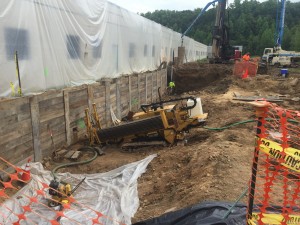Industrial Park Site Remediation
DTD has completed the installation of four ETEC groundwater injection wells beneath a industrial park building outside New York City. The building is owned by a developer who required minimal disturbance to his property, i.e., he did not want drill rigs inside his building to install vertical wells through the floor. The use of horizontal directional drilling allowed the equipment to be setup outside the building, such that the bores could be advanced under the building footer and beneath the building floor… all with the only disturbance inside the building being a person walking with a locating device.
The horizontal injection wells will be used to allow in-situ oxidation of contaminants found in the soils and groundwater beneath the building. Specifically the horizontal wells provide a pathway for groundwater with elevated dissolved oxygen (DO) to be injected below the building slab. The elevated DO allows the degradation of the site contaminants without either massive intrusion into or removal of the building.
Although the HDD project was reasonably straightforward (wells 75 – 100 ft long screened 6 ft below the building floor) this site came with its share of challenges. Contamination was also present in the soils surrounding the building, and those soils were excavated and hauled offsite. This required integration with the site works contractor to bring our drill rig in while the excavation was open. The drill rig was tracked into the excavation and set at a near horizontal pitch, to enter the ground through the shoring, and under the footer.
Geologically speaking, the site is near the terminus of the glacial advances of the Wisconsin Ice Age, and the ground conditions include glacial till with abundant boulder, cobble and gravel. Construction debris backfill including concrete added to the difficult drilling conditions. This required multiple passes and a variety of drill tooling to successfully install the injection wells. The cohesiveness provided by the small amount of fine sediment in this formation helped to keep the borehole stable after drilling through the cobbles and boulders, and each of these wells were completed as a blind installation. All project activities were completed during one week on site.
